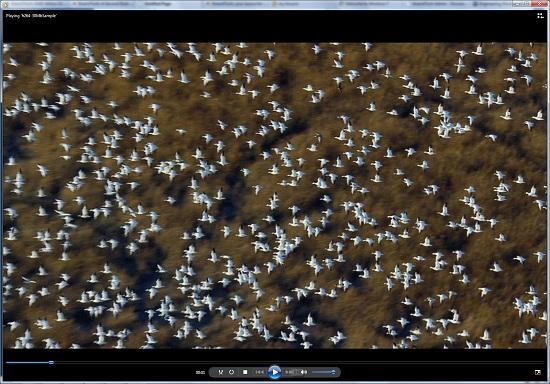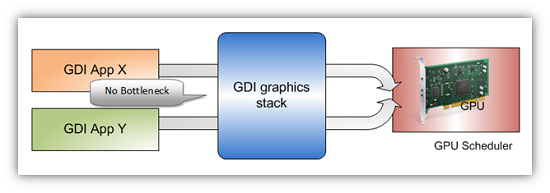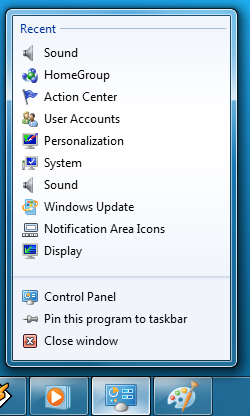Windows 7 Performance Guide
by Ryan Smith and Gary Key on October 26, 2009 12:00 AM EST- Posted in
- Systems
Feature Recap
As we have already covered the bulk of Windows 7’s new features in our look at the Windows 7 Release Candidate, we’re not going to spend too much time here. If you want an in-depth look at the new features, please see that article.
Performance
Vista’s performance was something of a quagmire. Even after SP1 fixed its biggest issues, it continued to be rather RAM hungry and poorly suited for low-end computers and newly minted cheap computers with the performance of older low-end computers. Netbooks made this situation particularly problematic for Microsoft, as their limited performance amplified this issue and resulted in netbooks shipping with Windows XP almost exclusively.
For Windows 7, Windows has been put on a diet in order to perform better on those machines. The most noticeable changes here are that Windows 7 eats less RAM and hard drive space out of the box than a comparable version of Vista did. There have also been some underlying tweaks to SuperFetch (it’s less aggressive on startup) and the kernel to improve responsiveness.
Our own experience here is that Microsoft has come through on this, although whether it’s enough is going to depend on just what someone is looking for. We have a few laptops where Vista was an absolute slug while Win7 runs just as well as Windows normally does. For someone looking for Win7 to perfectly replicate XP’s performance however, they’re going to come away disappointed – you’re never going to stuff something like Windows 7 in to the performance characteristics of an 8 year-old OS that forgoes real security and predates wireless networking.
Also while these changes should percolate to higher-end computers, the impact will be marginal at best. Vista had enough going on that it could bog-down low-end hardware, but hardware that as already capable of running Vista well isn’t going to greatly benefit from changes made to squeeze more out of the low-end. We’ll see this in detail later with our benchmarks.
Media
Windows’ media capabilities have been greatly augmented with Windows 7, primarily through the inclusion of decode and encode capabilities for a number of video and audio formats. While Vista included support for MPEG-2/1 and WMV9 video, Win7 has added support for much more contemporary codecs: H.264 and MPEG-4 (A)SP. Audio support has seen the inclusion of support for AAC and AAC+ audio, commonly found as companion audio streams for H.264 video, streaming internet radio, and portable media players.

Windows Media Player playing a 30Mb H.264 clip entirely in software without breaking a sweat
This gives Windows 7 the ability to play just about everything entirely out of the box, forging the need to deal with codec hell. The only notable things missing here are support for BluRay playback (you’ll need separate software), and some media container types (OGG, Matroska, MOV).
Encode support has been added for H.264 video and AAC audio through the Media Foundation Transcode class. This gives Win7 the ability to encode video on the fly for loading media on to portable media players and streaming to other devices (e.g. DLNA). However the use of this feature is quite limited at this time; only a handful of media players support the level of integration with Windows required to use the encoder. iPods need not apply.
Meanwhile Windows Media Center has seen its own improvements on top of the benefits it derives from greater codec support. At a high level this is a general UI touchup. At a low level this includes adding support for ClearQAM cable tuners, and the user-installation of CableCARD tuners.
Graphics
Windows 7 also brings about some additions to graphics capabilities. The headliner here is DirectX 11, whose introduction is being timed with the launch of Windows 7. DX11 is being released on Vista too any day now, so this is by no means an exclusive feature, but given the timing, it’s one of importance. We’ve already seen AMD launching their 5700 series and 5800 series ahead of Windows 7, so that they can have DX11-supporting cards on the shelves for this launch.
Windows 7-specific changes include the addition of WDDM 1.1, which is a minor update to the video driver stack for better memory utilization. This is accomplished by keeping the texture for a window (when using Aero for desktop composition) solely in VRAM instead of keeping a copy in local system memory too. WDDM 1.1 also brings support for heterogeneous display adapters, something Vista took away.
The GDI graphics stack has also been tweaked for performance reasons. Previously only a single application could write to it at once, making GDI writes a bottleneck. The stack has been changed so that now it’s the responsibility of the GPU to schedule multiple writes, rather than having an application blocked. We haven’t been able to find any performance cases where this is of help, however.

Images courtesy Microsoft
Low-Level
While Windows 7 is not the sizable overhaul of Windows that Vista was, it still has a few low-level changes. The biggest change for users is the official support for the TRIM command for SSDs, which will improve SSD write performance without the need for manual refreshes. The kernel’s dispatcher lock has also been rebuilt for better scaling; previously it effective topped out at 32 cores, now it scales to 256 cores. This will be more felt on the server branch, Windows Server 2008 R2.
Windows XP Mode
Primarily targeted at business users, Microsoft has officially added a derivative of their VirtualPC virtualization technology to Windows 7 in the form of Windows XP Mode. Windows XP Mode is a pre-configured Windows XP Pro virtual machine for running applications that just won’t run natively under Win7, allowing businesses to half-step to Windows 7 as part of a longer transition. It comes as a separate download available for Win7 Professional and higher editions, and no, it doesn’t run games.
Interface
The bulk of the changes in Windows 7 are going to be things that you can see, literally. Various interface elements have received drastic overhauls, and at the risk of slighting all of the other groups at Microsoft, more work appears to have been put in here than anywhere else.
Chief among these is the near-total replacement of the taskbar. The new Win7 taskbar is much closer to Mac OS X’s dock in appearance and function. Active applications appear on the taskbar as just large(r) versions of their application icon, and icons can be pinned in place so that they can be launched from the taskbar in the future, not unlike the old Quick Links feature. Undoubtedly, this is going to be the hardest thing for new users to get used to, although it’s certainly not hard to grow accustomed to.

The Control Panel Jump List
Along-side the dock taskbar are jump lists, which are replacing the normal right-click menu for items in the taskbar. Jump lists contain application specific commands, standard window manipulation commands, and recently used files for the application in question. Applications need to be coded to make full use of jump lists.
Also added are a pair of new Aero gestures. Aero Snap causes an application to be maximized when it’s dragged to the very edge of a screen, and returned to normal when dragged away. Aero Shake minimizes all other windows when a window has been shaken. Microsoft’s Rolodex-wannabe Flip3D is still here, much to our chagrin.
Other notable changes include gadgets, which have been liberated from the sidebar in order to reside on the desktop, and the classic Start Menu, which has been terminated entirely in favor of the Vista (and later) Start Menu. Finally, the whole default color scheme of Windows has been redone; pea green is out, blue/grey is in.
UAC
Finally, User Account Control, the fundamental underpinningsof Vista’s enhanced security, has also seen an overhaul. By reducing the integrity of UAC slightly so that by default it auto-elevates signed Microsoft programs, Microsoft hopes to reduce the perceived annoyance of UAC without compromising the actual security. As a result, UAC should be less noticeable, particularly when first setting up a computer. However there are possible security consequences of this, which we’ll get in to later











207 Comments
View All Comments
Matt Campbell - Monday, October 26, 2009 - link
Many people are having problems with the unpacker itself - and you still have to create the iso from the setup files.http://www.theregister.co.uk/2009/10/26/microsoft_...">http://www.theregister.co.uk/2009/10/26...osoft_wi...
JimmyJimmington - Monday, October 26, 2009 - link
No, it doesn't violate anything.Pjotr - Monday, October 26, 2009 - link
[quote]a 25% advantage over XP and 34% over Vista,[/quote]New reviewers, same old math error!
Windows 7 is 51% faster than Vista and 34% faster than XP, according to your graph. Windows 7 performs the job in 34% less time than Vista and 25% less time than XP, according to your graph.
ProDigit - Tuesday, October 27, 2009 - link
I'm sure those numbers are relative to which program you use; from battery point of view Win7 uses more battery to complete the task too.ViRGE - Monday, October 26, 2009 - link
No, they have it right. It's a lower is better test. Win7 completes the task in 75% and 66% of the time as XP and Vista respectively. That's 25% and 34%; 100% faster would mean the task is done instantaneously, and 51% faster would mean it's done in less than half the time.ddriver - Monday, October 26, 2009 - link
Hi there, I have a question/proposition for including those DPC latency issues Windows 7 is suffering from...I recently installed it and noticed the unsocially high values in the DPC latency meter. It manifested as awful audio drops and clicks in my DAW applications.
It seems there is some issue with power management drivers in Vista and 7, and while 7 seems a little better compared to Vista, the latency is still very problematic. The very same configuration in Windows XP is running at very low DPC latency, about 20 us (micro), while in 7 the machine idles at about 300 us, and even the most basic processor load results in spikes up to 3000-4000 us, which for an Average Joe that's watching movies or browsing the net will not be an issue, but for real time processing of audio or video, or capturing, it is critical, and the system is basically useless with Windows 7
So I guess this article is a nice place to investigate this problem, that seems to affect PCs with UPS or just a regular laptop, maybe given enough publicity the issue will be resolved.
ProDigit - Tuesday, October 27, 2009 - link
ASIO drivers take care for the audio part for you!I have little to no experience using live capture of video, but perhaps you will prefer a Linux or MacOs for that purpose (if video Latencies are that important).
chizow - Monday, October 26, 2009 - link
Its nice reading an honest account of the oft-marginal differences between Vista SP2 and Win7. I think far too much is made with regard to Win7's improvements, and while I do like Win7 for what it is, I agree its far less of a change from Vista than Vista was from XP.Basically it comes down to there's no really compelling reason to upgrade from Vista to Win7, but at the same time, there's no reason not to other than cost. Win7 is as most of your graphs show, about 5% better than Vista across the board with some UI tweaks, its a new and shiny toy with a new box and packaging.
As for a question you had about built-in e-mail programs:
Its just more of the same annoying anti-trust concerns that prevent Microsoft from bundling useful software that would benefit the end-consumer for the sake of fair competition. Its the same reason they can't bundle any variety of other useful and often free programs out there like codec packs, anti-virus, compression software, blu-ray playback, imaging software, photo viewers etc.
MS can't bundle them with the OS to give the other providers that offer them for free a chance to compete, and in the end it just ends up being a less pleasant experience for the end-user. This is probably the biggest difference imo compared to a Mac, with Mac this basic functionality you expect just works without having to search high and low for a working solution you expect to work for free out of the box.
davidhbrown - Monday, October 26, 2009 - link
It's interesting that no review I've yet read has mentioned that, if you turn off the GUI boot in msconfig to see the text status, Windows 7 identifies itself as version 6.1 compared to Vista's 6.0.I think that says a lot about the differences between Windows 7 and Vista. I'm very happy for the improvements, and I'm really starting to like the "peek" functions (way more functional than Expose). But it does feel more like an update than a whole new OS.
InternetGeek - Wednesday, October 28, 2009 - link
This was explained in a lot of usergroups and similar events in which MVPs and similar took the time to describe the numbering behing Windows 7.It turns out many software vendors write and compile their applications with conditions set to limit the versions of Windows on which their software run. In this case many developers who wrote software for Vista added a mask such that any revision of Vista (6.x) would run fine.
If Microsoft went forward in their usual way and changed the version of the kernel to 7.0 a lot of software would just brake or refuse to run even though the Operating System supported all their operations normally. To prevent this from happening Windows 7 uses a version number of 6.1. No one wants another Vista, we want Microsoft to look good from now on.
At the same time many Microsoft Evagelists, MVPs and similar have gone out of their way promoting the idea of not using this kind of technique and use feature discovery so programs can keep running as new versions of the operating system are introduced in the market.
Practices such as using newer APIs are being encouraged among software vendors and hopefully they will take the hint and make things easy for users. It is understandable they want to sell new copies with new OSs but they should do this on top of new functionality, not just some re-compilation and re-package.
On this sense, Microsoft often goes out of its way to accomodate some develoeprs requirements such as including software-specific and sometimes software-version-specific logic to accomodate functionality. This bloats the OS and starting from Windows 7 this will no longer be the case.
Check the engineering Windows 7 blog for more information on this, however, your local usergroup should be able to provide more details about this.
Hopefully, this post wont be lost in the hoopla.